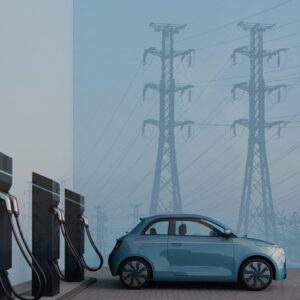
Graphic by Norie Wright
By Tiffany Vu
Edited by Annika McGraw and Courtney Schneider
As climate change remains at the forefront of policy making, a clear need for decarbonization of the energy sector has emerged. This movement away from fossil fuels and toward clean energy is called the energy transition, and is quickly transforming energy generation and distribution.While short-term battery storage is experiencing extreme growth as a solution to intermittency problems in these systems, it is still competing with established technology. This is especially the case in the use of fossil fuel peaker plants. At peak times where energy demand exceeds main grid supply, these plants are ready to add electricity to the grid with minimal uptime. Peaker plants are a last resort, only run during times of peak demand, and shut off when this demand decreases. These plants tend “to operate a few hundred hours a year, and often are older, more polluting facilities.”1 Currently, the U.S. has over 217 gigawatts of fossil-fueled peaker capacity (Figure 1), much of which relies upon natural gas.2 Over 70% of this total capacity is located within or near urban areas, often near disadvantaged communities.3 Close proximity to urban areas allows for quick access to reliable energy during peak times, but emissions of “nitrous oxides, sulfur oxides, and particulates into the surrounding community” also have negative impacts.4
Figure 3. Strategen. Energy Storage for Peaker Plant Replacement (2022).
Natural gas peaker plants can provide energy in a matter of minutes and have proven a reliable source of peak energy generation. However, peaker plants release carbon dioxide, nitrogen oxide, and sulfur dioxide, making it among the dirtiest methods of energy production given negative health impacts that disproportionately affect low-income communities.5 Our current grid is not working well, and peaker plants only add to the problem–especially on days with high levels of air pollution. In fact, a report by Physicians, Scientists, and Engineers for Healthy Energy (PSE) found that in California, “peaker plants disproportionately operate on days when smog levels already exceed federal standards, exacerbating local air quality and public health risks” and that half of the peaker plants in California are located in disadvantaged communities.6 These peaker plants not only harm the environment and the overall well-being of humans, they also disproportionately affect already disadvantaged communities.
Prior to 2014, natural gas peaker plants were the cheapest method of fulfilling peak demand. According to the California Independent System Operator, in 2017 the battery storage necessary to meet peak demand came at a cost 2.7 times that of a natural gas peaker plant.7 At that point, preliminary analyses found that energy storage prices would need to decrease drastically to viably compete with peaker plants.8 Energy storage costs had been falling faster than predicted and were expected to continue falling as economies of scale were reached and new technologies introduced.This steep decline in price was partially due to specific, state-level clean energy goals and federal tax credits. As of 2021, total cost for a four-hour utility-scale battery was $132/MWh, $41/MWh less than the global natural gas peaker plant average of $173/MWh.9 The total price of battery storage may fall even further with additional federal credits from the Inflation Reduction Act (IRA) and the Infrastructure Investment and Jobs Act (IIJA).10
Other benefits of short-term battery storage include improved reliability, resilience, and flexibility; and shorter uptimes.11 While natural gas peaker plants can deploy energy in a matter of minutes, battery energy storage can do so in seconds.12 This allows for better integration of diverse energy sources, which not only makes battery storage resilient to single-source intermittency issues, but also positions it as a solution to them. By contrast, if natural gas supply were cut off, peaker plants would be unable to operate. Finally, short-term battery storage reduces environmental impacts significantly compared to peaker plants. As short-term battery storage does not require actual energy generation at the time of deployment, it does not generate any harmful pollutants.
Continued Challenges with Battery Storage
The overall price of short-term battery storage is no longer the challenge, but other challenges arise.
Perceptions of High Prices
Only five years ago, the price of battery storage was almost three times higher than that of a peaker plant.13 Today, prices are comparable to those of natural gas peaker plants. The costs of battery storage continue to fall, but decision-makers do not always follow price projections of new technologies and may have outdated notions about the cost comparison. This misconception can influence decision-makers’ consideration of battery storage as an option, and could lead them to prefer peaker plants or other storage solutions.
Outdated Regulatory Policy
Regulatory policy often lags behind new technology; it is to be expected that regulatory policy for the electrical grid and battery storage is far behind. Currently, most regulatory policies do not “recognize the flexibility of storage systems or allow them a level playing field.”14 This means that benefits from battery storage cannot effectively be realized in regulatory environments that do not allow them to exist at their full capacity. Battery storage is useful across many processes–including energy generation, transmission, and distribution–and clarity is still needed on how this can be regulated.15 Policies need to be updated to both enable more effective integration of battery storage into existing systems and to allow emergence of other technologies that improve energy generation and distribution.
Outdated Market Design
Though the Federal Energy Regulatory Commission (FERC) created opportunities for battery storage in the wholesale market, retail rules regarding energy distribution are still lagging. As interest from consumers and businesses grows, so does the need for tiered energy prices. This is often discussed as time-of-use pricing where rates are determined based on demand: if demand increases, prices also increase to encourage a more stable flow of energy throughout the day. If this tiered pricing system is not able to be used, then battery storage loses its more attractive aspect which is “the ability to facilitate rate arbitrage by storing electricity when it is cheap and selling it when it is expensive.”16 This is incredibly important for making battery storage a potential solution because it allows for cheap generation of renewable energy (when the sun is shining and the wind is strong) and for distribution of this energy at a higher price which would help justify the upfront cost of investing in battery storage.
Safety Issues
As battery storage continues to grow at breakneck speed, it is also critical to address the potential safety issues that may arise. Fires are potential safety issues at battery storage facilities, the most recent example of which occurred at a battery storage site in Arizona when one internal cell failed leading to “an extensive cascading thermal runaway event.”17 This site experienced a catastrophic failure, and many first responders were injured in the fight to stop the fire. Battery fires are more dangerous than regular fires because they are incredibly difficult to extinguish.18 Current firefighter protocols are not as effective against battery fires, so additional training challenges arise with safely combatting potential fires and setting up appropriate processes to prevent such fires from happening.
Raw materials
Battery storage requires a wide range of critical minerals, including lithium and copper, that are costly to mine.19 The resources that need to be allocated to mining include energy and freshwater but there are also the side effects of producing greenhouse gasses and waste. An additional side effect is that these minerals are often found in low-income communities and areas within the developing world that will need to bear the majority of pollution that is generated during the mining process.
Potential Solutions
There are significant barriers that need to be addressed in order for short-term battery storage to continue its extreme growth. As important as market solutions are, policy still needs to be created to better support the sustainable growth of battery storage to replace peaker plants.
Perceptions of decision-makers: Perception might not be reasonably addressed by policy, but it is important to establish periodic checks of developing technologies as their costs, prices, challenges, and benefits are subject to change in a short period of time. If decision-makers continue to hold outdated notions of technologies, a huge gap can occur in the underdevelopment or limited uptake of technologies that can help more holistically decarbonize the grid, including battery storage. This can be remedied by having a team quarterly assigned to review emerging technologies and evaluate the costs and benefits of the new technology. The critical aspect of this team is to be flexible to changing numbers and unknowns. This may be a space in which the public may want to collaborate with venture capital companies that are familiar with evaluating startups.
Outdated regulatory and market design: Battery energy storage has the ability to play a major role in the energy system, but regulation and market design that allows battery energy storage to realize its full potential is lacking. There need to be clear definitions as to what battery energy storage is and how regulators around the U.S. can regulate this technology. This will require substantial updates to current regulations under FERC, state energy commissions, and the Department of Energy. This will also require collaboration with the private sector to ensure that the regulations and policies developed can help guide market design to ensure effective integration of energy storage into the current energy system.
Improved Safety policies: Concerns with safety are not to be taken lightly, and concerns with battery fires are ones that need to be addressed. Safety policies on how to run a battery storage facility and how to put out fires are necessary right now given that battery storage is already in use across many states that do not have updated policies. The key federal government entity for these policies is the U.S. Fire Administration (USFA) which is a division of the Federal Emergency Management Agency (FEMA).20 New policies and processes need to be developed to ensure that risky management of battery storage facilities does not occur and ideally minimize the risks and the likelihood of fires breaking out in the first place. The second is to also establish a battery fire combating process to ensure that fires are put out in the safest way possible.
Conclusion
Energy storage will be a critical aspect of the energy transition, but it will need to come in many forms. Short-term energy storage may help solve daily energy demands and help during peak periods, but it cannot be relied upon as the sole form of U.S. energy storage. Other, more long-term energy storage methods will be critical for ensuring long-term reliability and resiliency. Nevertheless, to help decarbonize peak demand, short-term energy storage is a solution that is expected to grow substantially in the near future, but there do need to be more updates in regulations and policies to ensure that this growth is sustainable and does effectively help decarbonize the U.S. energy system. Intentional policies will drive a more carefully delivered and resilient energy system.
Endnotes
1. Wasser, Miriam, “What to Know about a Planned Natural Gas ‘peaker’ Plant in Mass.,” April 8, 2022, https://www.wbur.org/news/2022/04/08/peabody-peaker-natural-gas-power-massachusetts.
2. Robbins, Shelley et al., “Energy Storage for Peaker Plant Replacement,” https://files.dep.state.pa.us/Energy/Office%20of%20Energy%20and%20Technology/OETDPortalFiles/EnergyAssurance/PA_Energy_Storage_Consortium_Meeting4_Deck_5.17.22.pdf.
3. ibid
4. Mullendore, Seth, “Why We Must Shut Down Polluting Urban Power Plants,” US News & World Report, May 27, 2020, //www.usnews.com/news/cities/articles/2020-05-27/its-time-to-shut-down-polluting-urban-power-plants.
5. Meltek, “Peaker Plants: A Nationwide Problem.” n.d. Retrieved from https://meltek.io/peakers-a-nationwide-problem.
6. Ramirez, Rachel, “These Dirty Power Plants Cost Billions and Only Operate in Summer. Can They Be Replaced?,” Grist, May 8, 2020, https://grist.org/justice/these-dirty-power-plants-cost-billions-and-only-operate-in-summer-can-they-be-replaced/.
7. California ISO, “Moorpark Sub-Area Local Capacity Alternative Study,” August 16, 2017, https://efiling.energy.ca.gov/URLRedirectPage.aspx?TN=TN220813_20170816T165328_Moorpark_SubArea_Local_Capacity_Study.pdf.
8. Spector, Julian, “In Storage vs. Peaker Study, CAISO’s Outdated Cost Estimates Produce Higher Price Tag for Storage,” August 31, 2017, https://www.greentechmedia.com/articles/read/energy-storage-nrg-puente-gas-peaker-plant-cost.
9. Robinson, J., DiChristopher, T., and Micek, K., “Natural Gas in Transition: Grid-Balancing Tactics in Flux as Battery Costs Fall,” June 8, 2021, https://www.spglobal.com/marketintelligence/en/news-insights/latest-news-headlines/natural-gas-in-transition-grid-balancing-tactics-in-flux-as-battery-costs-fall-64822077.
10. ibid
11. Energy Storage Association, “Benefits of Energy Storage | Energy Storage Association,” Energy Storage Association (blog), 2021, https://energystorage.org/why-energy-storage/benefits/.
12. Bowen, Thomas, Chernyakhovskiy, Ilya, and Denholm, Paul, “Grid-Scale Battery Storage: Frequently Asked Questions,” September 2018, 8.
13. California ISO, “Moorpark Sub-Area Local Capacity Alternative Study.”
14. Deloitte Center for Solutions, “Challenges and opportunities of battery storage,” Deloitte Netherlands, 2021, https://www2.deloitte.com/nl/nl/pages/energy-resources-industrials/articles/challenges-and-opportunities-of-battery-storage.html.
15. Bowen, Thomas, Chernyakhovskiy, Ilya, and Denholm, Paul, “Grid-Scale Battery Storage: Frequently Asked Questions,” September 2018, 8.
16. Deloitte Center for Solutions, “Challenges and opportunities of battery storage.”
17. Ciampoli, Paul, “Recent California Energy Storage Battery Fire Draws Renewed Attention to Storage Safety Issues | American Public Power Association,” October 17, 2022, https://www.publicpower.org/periodical/article/recent-california-energy-storage-battery-fire-draws-renewed-attention-storage-safety-issues.
18. Fischer, Anne, “Battery Fire at Salt River Project in Arizona,” pv magazine USA, April 26, 2022, https://pv-magazine-usa.com/2022/04/26/battery-fire-at-salt-river-project-in-arizona/.
19. Crawford, Iris, “Will Mining the Resources Needed for Clean Energy Cause Problems for the Environment?,” MIT Climate Portal, July 21, 2022, https://climate.mit.edu/ask-mit/will-mining-resources-needed-clean-energy-cause-problems-environment.
20. “U.S. Fire Administration,” accessed December 5, 2022, https://www.usfa.fema.gov/.





